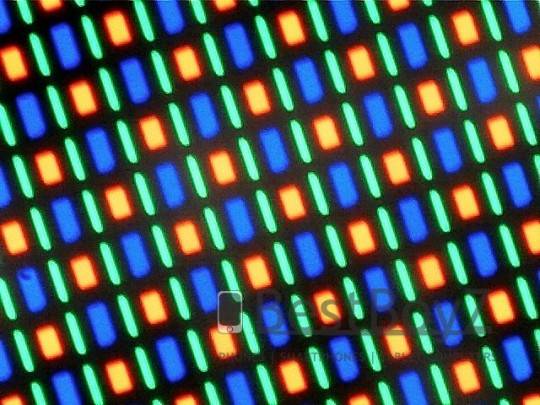
There’s some downright fantastic screen technology out there today, and nearly all of it is making its way into brand new smartphones. To get an up close and personal look at some of themore high-end options, German site BestBoyz took a look at the screens on the HTC One X, HTC One S and the LG Optimus 4X HD under a 400-power microscope. You can see the individual pixel shells whose color combinations make up the image. Fist, the HTC One X:
Unlike its smaller brother, the One X uses a Super LCD2 panel made by Samsung. This uses the traditional red-green-blue cell method, combining the primary light colors to create individual shades. HTC told the source that while the quality of Super LCD2 approaches that of IPS and in fact uses much of the same technology, they can’t call it “IPS” for trademark reasons. The screen on the HTC One X is a full 1280×720 panel measuring 4.7 inches diagonally.

The LG Optimus 4X HD uses a screen that’s the same size and density as the One X, but uses a more conventional IPS (in-plane switching) LCD panel provided by LG itself. LG calls it a “True HD IPS”. As you can see, the LG screen has a somewhat “colder” light, with the green cells aparently washed out under the microscope. In our experience, LG’s IPS displays tend to be very, very accurate as far as color goes (note the warm quality of the One X panel) but considerably less bright than standard LCD or AMOLED displays.

Speaking of which, above is the AMOLED (active-matrix organic light-emitting diode) screen from the HTC One S. The One S has a 4.3-inch screen (probably supplied by Samsung) with a resolution of 940×560. This gives it about 20% less pixel density than the One X or the Optimus 4X HD. In addition, the Pentile screen matrix construction means that each green sub-pixel shares a red and blue sub-pixel with another green sub-pixel, making the absolute pixel density considerably lower than a traditional LCD screen. Many users compain abou this loss in definition, but others prefer the brighter and generally more saturated colors on AMOLED.
There you go, screen junkies – let us know what you think of the three screens in the comments section.
[Thanks to Kote for the tip!]










The AMOLED display on the One S is just like that of the Sensation… Which is disappointing. Anyone who had had the opportunity to compare this type of screen to an IPS panel can agree that the colors appear to be more faded… especially the reds. Samsung is doing the exact same thing with their hdtv panels… Cost-cutting measures. Go for pixel density.
The HTC Sensation does not have an AMOLED display, and it never has. It has a Super-LCD display.
They are the same qHD resolution but yes Simplicity is correct. The Sensation has a Super LCD, not an AMOLED
already been corrected once, does not need correcting again….
I see, my mistake. I guess I just meant the pixel density and pattern is similar between the two. I noticed immediately that the colors appear more faded in the Sensation… And it looks as though the One S will follow suit. Sorry for the lack of terminology to properly explain lol.
In short: No. Colors will NOT be faded or unsharp in One S. Quite opposite.
Thats EXACTLY where AMOLED is superior to SLCD (not counting SLCD2, as that is clearly ips copy). Try a Galaxy S, Nexus S or Moto Razr, Google Nexus 1. You will see just how vibrant and sharp colors are compared to “normal” screens.
(I say this because I own original Desire with AMOLED. And wife has a Galaxy S (Super AMOLED) in my house there are HTC Desire HD (SLCD) and Xperia Arc S (LCD).
Of them all, Desire HD (SLCD) takes last place, LCD in Arc S is barely better. Desire AMOLED is way ahead but superAMOLED beats it in view angles and vibrance.
One thing that I never see discussed in all the screen panel articles is the latency. It’s doesn’t matter to me because I don’t game much but they do measure it on desk top screens. Just curious as to why.
Give Samsung Galaxy S3 Lg Optimus 4X HD’s screen and t’ll be the best smartphone ever, it is the best smartphone but lacks in some areas
Give Samsung Galaxy S3 Lg Optimus 4X HD’s screen and t’ll be the best smartphone ever, it is the best smartphone but lacks in some areas